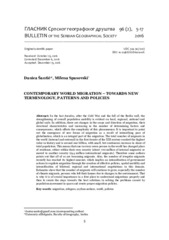Приказ основних података о документу
Contemporary world migration - towards new terminology, patterns and policies
| dc.creator | Šantić, Danica | |
| dc.creator | Spasovski, Milena | |
| dc.date.accessioned | 2021-09-24T15:35:31Z | |
| dc.date.available | 2021-09-24T15:35:31Z | |
| dc.date.issued | 2016 | |
| dc.identifier.issn | 0350-3593 | |
| dc.identifier.uri | https://gery.gef.bg.ac.rs/handle/123456789/779 | |
| dc.description.abstract | In the last decades, after the Cold War and the fall of the Berlin wall, the strengthening of overall population mobility is evident on local, regional, national and global scale. In addition, there are changes in the scope and direction of migration, their structural characteristics and increasing in the number of determining factors and consequences, which affects the complexity of this phenomenon. It is important to point out the emergence of new forms of migration as a result of intensifying pace of globalization, which is an integral part of the migration. The total number of migrants in the world (internal and external) in the first decade of the XXI century reached the highest value in history and is around one billion, with small, but continuous increase in share of total population. This means that one in every seven person in the world has changed place of residence, either within their own country (about 700 million of internal migrants) or moved to another country (244 million international migrants). Therefore some authors points out that all of us are becoming migrants. Also, the number of irregular migrants recently has reached its highest amount, which implies an intensification of government actions to regulate migration through the creation of effective policies, spatial mobility and intensification of bilateral, regional and international negotiations in this domain. Estimates show that the number of migrants will continue to grow, especially the number of climate migrants, persons who left their homes due to changes in the environment. That is why it is of crucial importance in a first place to understand migrations properly and then to create the steps towards the best solutions in solving the problems caused by population movement in space and create proper migration policies. | |
| dc.publisher | Beograd : Srpsko geografsko društvo | |
| dc.rights | openAccess | |
| dc.rights.uri | https://creativecommons.org/licenses/by-nc-nd/4.0/ | |
| dc.source | Glasnik Srpskog geografskog društva | |
| dc.subject | migration | |
| dc.subject | refugees | |
| dc.subject | asylum seekers | |
| dc.subject | world | |
| dc.subject | policies | |
| dc.title | Contemporary world migration - towards new terminology, patterns and policies | en |
| dc.type | article | |
| dc.rights.license | BY-NC-ND | |
| dcterms.abstract | Спасовски, Милена; Шантић, Даница; | |
| dc.citation.volume | 96 | |
| dc.citation.issue | 2 | |
| dc.citation.spage | 5 | |
| dc.citation.epage | 17 | |
| dc.citation.other | 96(2): 5-17 | |
| dc.citation.rank | M51 | |
| dc.identifier.doi | 10.2298/GSGD1602001S | |
| dc.identifier.fulltext | https://gery.gef.bg.ac.rs/bitstream/id/686/777.pdf | |
| dc.identifier.rcub | https://hdl.handle.net/21.15107/rcub_gery_779 | |
| dc.type.version | publishedVersion |


